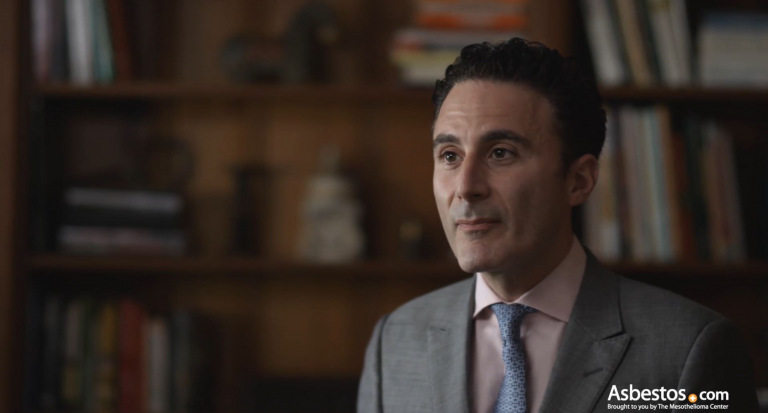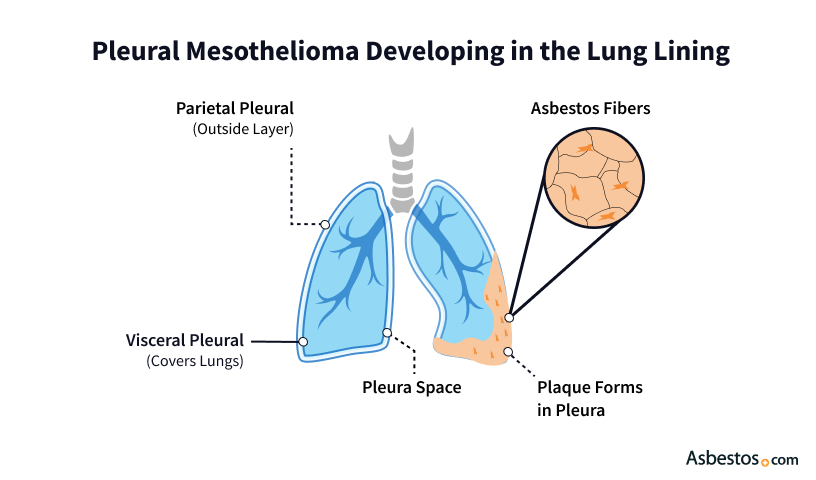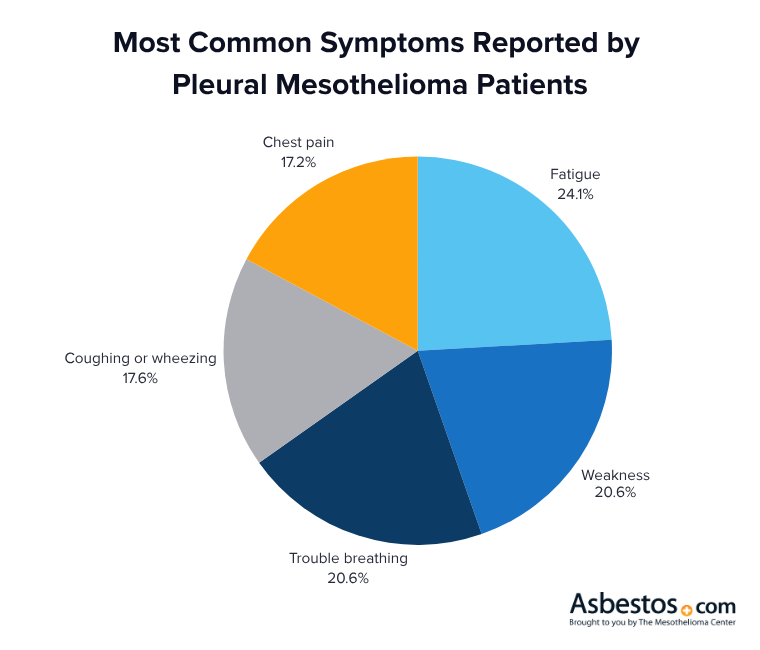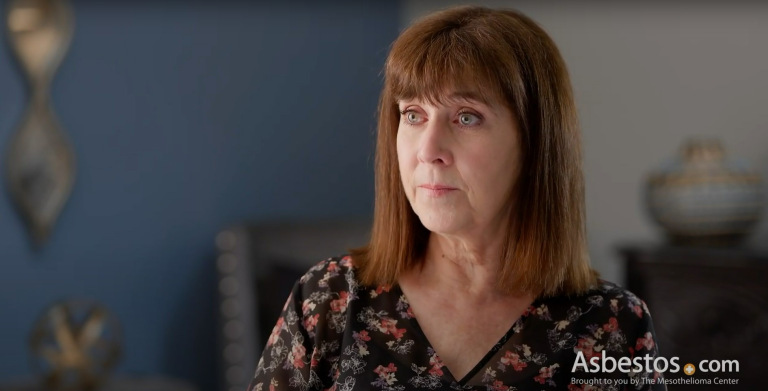Pleural Mesothelioma
Pleural mesothelioma, also called malignant pleural mesothelioma, is a rare cancer of the lung lining. Asbestos is the primary cause. Symptoms may include chest pain, shortness of breath and fluid buildup in the chest. Though prognosis is often poor, new treatments may improve survival.

Expert Take
Dr. Jacques Fontaine: What is pleural mesothelioma?
And then on the periphery of the lung, the lining of the lung called the pleura, they can start causing inflammation. And over many years--
and I'm talking about 25 to 30 years--
that inflammation very, very rarely can turn into a cancer. And that cancer is called mesothelioma.
Mesothelioma occurs most often in the lining around the lung called the pleura. And that's what pleural mesothelioma is.

Expert Take
Dr. Jacques Fontaine: What is pleural mesothelioma?
And then on the periphery of the lung, the lining of the lung called the pleura, they can start causing inflammation. And over many years--
and I'm talking about 25 to 30 years--
that inflammation very, very rarely can turn into a cancer. And that cancer is called mesothelioma.
Mesothelioma occurs most often in the lining around the lung called the pleura. And that's what pleural mesothelioma is.
What Is Pleural Mesothelioma?
Pleural mesothelioma is a rare and aggressive type of cancer that grows in the pleura. The pleural membrane covers your lungs and lines your chest cavity. Its tumors can look like plaques or nodules at first. But as pleural mesothelioma progresses, tumors can merge to form a sheet-like mass. Because tumors can resemble other cancers, making an accurate diagnosis is challenging.
Doctors in the U.S. diagnose under 3,000 new cases of pleural mesothelioma each year. It’s the most common of the 4 different types of mesothelioma, making up about 75% of all cases. Pleural mesothelioma makes up 70% to 79% of all cases of mesothelioma. Doctors often call this cancer malignant pleural mesothelioma or MPM.
Given its rarity, most people diagnosed with pleural mesothelioma have never heard of it. Jeanne Niemiec, whose husband Bob received a pleural mesothelioma diagnosis in 2019, tells us how they felt when they first heard about his diagnosis. “We had no idea what it was,” Jeanne Niemiec tells us. Her husband, Bob, received a pleural mesothelioma diagnosis in 2019. “I’d never even heard of it before, and neither had Bob or our kids.”
What Causes Pleural Mesothelioma?
The primary cause of pleural mesothelioma is asbestos exposure. When inhaled, asbestos fibers lodge in the pleura, the thin lining made of parietal and visceral layers, where they irritate tissues, create scar buildup and may trigger cancer over decades.
Over many decades, this irritation from asbestos fibers can change cell DNA. These DNA mutations can lead to cancer. Some researchers say other factors may play a role. Radiation and genetic mutations, such as BAP1 mutations, can also contribute to the development of mesothelioma. But asbestos exposure remains the main cause.

Risk Factors for Pleural Mesothelioma
Occupational asbestos exposure is the No. 1 cause of pleural mesothelioma. Many jobs put workers at risk of asbestos exposure. Construction, manufacturing, the military and shipbuilding industries used asbestos. While most companies phased out asbestos in the 1980s and 1990s, workers today may come into contact with older or legacy asbestos products.
Who Is at Risk of Asbestos Exposure?
- Auto mechanics
- Construction workers
- Demolition crews
- Factory and industrial workers
- Firefighters
- Insulators
- Military personnel
- Miners
- Power plant workers
- Shipyard workers
People living with those who come into contact with asbestos at work can also be at risk of developing pleural mesothelioma. Asbestos fibers can be brought home on clothing, shoes, gear, skin and hair. This is called secondary asbestos exposure.
Secondary exposure led to Shaun Bigbie’s pleural mesothelioma diagnosis. His father and uncle encountered asbestos while working at the Ford Motor Company. Shaun tells us, “They think somewhere along the line, my father brought asbestos on his clothing home to me. My uncle said there were days you would just see fibers everywhere in the air.”

Learn about your diagnosis, top doctors and how to pay for treatment in our updated 2025 guide.
Get Your Free GuideRecognizing the Symptoms of Pleural Mesothelioma
The most common symptoms of pleural mesothelioma are shortness of breath, back and chest pain and fatigue. Pleural effusions, or fluid around your lungs, can be one of the first signs of this disease. Pleural thickening and pleural plaques can also be signs.
Because pleural mesothelioma symptoms often mimic pneumonia or lung cancer, diagnosis is frequently delayed. Doctors diagnosed Joey Barna with pleural mesothelioma after he felt fluid in his lungs. His symptoms were first mistaken for pneumonia. Our Patient Advocates helped him get a proper diagnosis and treatment. Joey tells us he’s feeling great today and living life to the fullest.
Common Pleural Mesothelioma Symptoms
Early signs of pleural mesothelioma are mild and easy to ignore. Some people wait to see a doctor until symptoms worsen, which lessens treatment options. It’s important to talk to your doctor if you have a history of asbestos exposure, feel sick or something doesn’t feel right. Finding mesothelioma early can get better care.
Common Symptoms Among Patients
In 2025, we surveyed more than 170 people with pleural mesothelioma, caregivers and their loved ones about which symptoms they most experience. Results showed fatigue was most common. Because the symptoms of pleural mesothelioma are often mistaken for those of other illnesses, it’s best to see a doctor who specializes in treating this cancer.

How Is Pleural Mesothelioma Diagnosed?
A pleural mesothelioma diagnosis typically begins with a physical exam and imaging scans like chest X-rays and CT scans. If your scans show fluid buildup or pleural thickening, your doctor will order a biopsy to analyze a tissue sample. Doctors may look for biomarkers such as soluble mesothelin-related peptides (SMRP) or genetic changes like BAP1 mutations to aid in diagnosis. A biopsy is necessary to confirm a pleural mesothelioma diagnosis.
Tests Used to Diagnose Pleural Mesothelioma
- Physical Exam: First, your doctor will check for abnormalities like a skin bump. They’ll also check tender or painful areas.
- Blood Tests: Next, blood may be drawn. These tests allow experts to look for signs like biomarkers, such as proteins or certain genetic mutations, indicating pleural mesothelioma.
- Imaging Scans: X-rays, MRI, CT and PET scans spot the location of pleural tumors.
- Biopsy: During a short surgery, your doctor will remove a small piece of tissue to check for cancer cells.
Getting a second opinion from a pleural mesothelioma expert can ensure your diagnosis is correct. Seeing a specialist can get the right care. It’s OK to ask for another doctor’s opinion.
What to Expect During the Pleural Mesothelioma Diagnosis Process
If you or a loved one is facing the uncertainty of mesothelioma, understanding the steps in the diagnosis process can help ease some of the anxiety. Here’s a simple guide to show you what to expect as you move through each stage of diagnosis. We’re here to support you every step of the way.
Initial Consultation with Doctor
Chest X-Ray
CT Scan
Biopsy
Mesothelioma Diagnosis Confirmed
Stages of Pleural Mesothelioma
Your pathology report will likely tell you the stage of your pleural mesothelioma. Stages show how far your cancer has progressed. Early mesothelioma stages mean tumors are close to the area where they first developed. Later stages mean cancer has spread further.
Pleural Mesothelioma Stages
- Stage 1: Tumors form in and around the pleura of one lung.
- Stage 2: Cancer cells spread beyond the pleura, entering nearby lymph nodes.
- Stage 3: Cancer spreads to tissues in the chest and distant lymph nodes.
- Stage 4: Tumors affect distant parts of the body like the liver and bones.
Doctors use what’s called the TNM staging system when diagnosing pleural mesothelioma. TNM stands for tumor, node and metastasis. The system identifies the cancerous growths, their effect on lymph nodes and extent of cancer spread.
Dr. Jeffrey Velotta, a pleural mesothelioma expert at Kaiser Permanente Oakland Medical Center in California, told us about new updates to the TNM staging system for pleural mesothelioma. Dr. Velotta explains, “Standardizing measurements of tumors can help improve treatment guidelines and prognostic information.” The American Joint Committee on Cancer included more details to refine the staging process in January 2025.
Treatment Options for Pleural Mesothelioma
Doctors treat pleural mesothelioma with surgery, medicine and other therapies. Sometimes, they combine more than one kind of treatment to help you feel better or live longer. Doctors call this multimodal therapy. Other care, like pain relief, also helps improve daily life.
Among mesothelioma surgeons we surveyed, nearly 67% of them reported extrapleural pneumonectomy produces the best overall outcomes for eligible pleural mesothelioma patients, highlighting its role as a leading surgical approach
- Chemotherapy: These drugs kill pleural cancer cells or slow their growth. Common ones include Alimta (pemetrexed), Paraplatin (carboplatin) and Platinol (cisplatin).
- Clinical trials: Doctors test new treatments in clinical trials. You may qualify to try new therapies for pleural mesothelioma.
- Immunotherapy: This helps your body’s immune system fight cancer. It even helps resistant cell types of pleural mesothelioma. FDA-approved drugs include Keytruda (pembrolizumab), Opdivo (nivolumab) and Yervoy (ipilimumab).
- Palliative care: This care focuses on helping you feel better, not curing cancer. It can be used to manage both disease symptoms and treatment side effects like using medicine to ease pain.
- Radiation therapy: This uses strong X-rays to kill pleural mesothelioma cells or shrink tumors. It can help with treatment or make you feel more comfortable.
- Surgery: Doctors may remove the tumor, the lung or the lining of the lung to help treat the cancer. This is usually done in the early stages and may be used with other treatments.

Survivor Story
Carla Fasolo: Pleural mesothelioma survivor discusses her experience receiving treatment
And, you know, the first few times was kinda hard because I would be sleeping a lot and, you know, it it does have its effect on you, the the medications that they give you and everything.
But had positive outcome.
They had told me that my tumor was the size of a softball when I it started, fracturing my ribs and then damaging ribs.
And then, after my third, therapy, the tumor had shrunk quite a bit. And that was amazing. To me, that was awesome, you know. And, it has had continued to do so in my therapy.
I was scheduled to have surgery but it got postponed twice, and I decided that it was kind of a sign not to have the surgery done. So I talked to doctor DaSilva about it, and, he said that was fine. And that it came to that point where I needed surgery, He’d take care of it. He’s very good.
He’s, when he found out that my daughter was a doctor, he wanted to call her. He called her right away and talked to her and told her, you know, what I was going through, what I had.
Yeah.
In January 2025, the American Society of Clinical Oncology shared new guidelines for treating pleural mesothelioma. They now suggest using treatments that keep the lung instead of removing it. Immunotherapy is often preferred over chemo because it may help people live longer. A new drug mix, including Keytruda and chemo, was also approved to treat advanced cases.
Reflections from a Mesothelioma Survivor
Mesothelioma treatments can be tough, and things may look bad, but there is hope. Don’t give up too soon!
Treatment Recommendations Among Doctors
The Mesothelioma Center at Asbestos.com surveyed doctors and nurses in 2025 about the best treatment approaches for people with pleural mesothelioma. Respondents said the preferred treatment is chemotherapy with immunotherapy, which aligns with the newest treatment options for pleural mesothelioma.
| Treatment Approach | % of Respondents |
|---|---|
| Chemotherapy + Immunotherapy | 39% |
| Surgery (e.g., P/D or extrapleural pneumonectomy) | 18% |
| Multimodal (combination of surgery, chemo, immunotherapy, radiation) | 17% |
| Chemotherapy (e.g., pemetrexed + cisplatin/carboplatin) | 16% |
| Palliative/supportive care | 10% |
Finding the Best Pleural Mesothelioma Doctor
Pleural mesothelioma specialists include oncologists, surgeons and radiologists. They work at mesothelioma treatment centers across the country. Finding the right specialist for you can depend on the stage of your cancer, treatment goals and personal preferences.
Your doctor can refer you to a specialist. Patient Advocates can also match you with a specialist. They’ll find one with a lot of experience treating similar cases as yours.
“With this disease, finding a specialist is critical,” Dr. Jacques Fontaine tells us. Dr. Fontaine heads the Mesothelioma Research and Treatment Center at Moffitt Cancer Center in Tampa. “You need someone who truly understands it. They must know how to treat it aggressively for the best outcome.”

Filled with thoughtful items to bring comfort and encouragement while undergoing treatment.
Get Your Free KitPrognosis for Pleural Mesothelioma
Pleural mesothelioma prognosis is usually poor, but outcomes are individual, and some factors can improve it. Survival rates measure the percentage of people with pleural mesothelioma who are still alive after a certain period of time. They don’t predict exactly what will happen to you. Everyone is different, and your doctor can explain what these numbers mean for you.
| Pleural Mesothelioma Stage | Average Life Expectancy | 5-Year Survival Rate |
|---|---|---|
| Stage I | 21 months or more | 22.5% |
| Stage II | 19 months to 5 years | 11% |
| Stage III | 16 months to 4.5 years | 16% |
| Stage IV | 12 months to 2 years | 7% |
Life expectancy is the average amount of time a person may live with pleural mesothelioma. Life expectancy for pleural mesothelioma is often less than 18 months. The median survival ranges from 8 to 14 months. An early-stage diagnosis at a younger age increases treatment options. Aggressive treatment and good overall health are other factors that improve life expectancy.
Factors That Affect Prognosis
Predicting someone’s prognosis is complex and challenging. A number of factors play a role. Some survivors have lived with pleural mesothelioma for many years.
- Age: Younger patients tend to live longer.
- Cell type: Your specific mesothelioma cell type can impact treatment effectiveness.
- Gender: Women tend to live longer with the disease than men.
- Healthy lifestyle: Those who exercise and have better nutrition tend to have a better prognosis.
- Pleural fluid: Those with more pleural fluid in their chest often have a worse prognosis.
- Recurrence: Mesothelioma returning is associated with a poorer prognosis.
- Stage: This is the most important factor. A diagnosis in the early stages may lengthen survival.
No doctor can determine your life expectancy based only on a diagnosis of pleural mesothelioma. This cancer advances at a rapid pace, but treatment can control it. People with pleural mesothelioma are living longer and enjoying a better quality of life thanks to treatment advances.

Exclusive Content: A Caregiver’s Perspective
Jeanette Mednicoff: Advice for someone who has a loved one diagnosed with mesothelioma
Support does come in many different forms and different manners.
I think that emotional support, first and foremost, is huge just being there for them just listening to them, just letting them, you know, lean on you to tell you whatever it is they’re feeling. Because they’re probably gonna have some really big feelings about what’s going on. Support can also be showing up with meals, you know, helping with errands, going over and, you know. Perhaps offering to clean the house, just sit and have a cup of tea. Kim loves, to drink tea. Just being there for her, just really showing up however you can.
Ask them, you know, “what can I do to help you?”
I think one of the things I discovered is that I kinda had a catchphrase with Kim. So quite often through this whole entire journey from start to finish or to where we are here today.
One thing I would do is call her on the phone and say, what do you need from me?
Basically, what can I do to help you?
Is it making calls? Is it, you know, scheduling something? Whatever it is, I would say that’s the best way to support your friend or family member with this diagnosis.
Living With Pleural Mesothelioma
Long-time survivor Michael Cole shares his tips for living with pleural mesothelioma. He recommends staying hydrated, eating a healthy diet and staying active. He also says, “It is crucial to maintain good mental health.”
5 Tips for Living With Pleural Mesothelioma
- Eat healthy foods like fruits and vegetables to help your body stay strong.
- Find ways to relax, like deep breathing or listening to music, to feel less stressed.
- Stay connected with people who care about you, like family and friends, for support.
- Talk to your doctor about any pain you have and how to manage it.
- Try to move your body every day, even if it’s just a short walk.
Sissy Hoffman has lived with pleural mesothelioma for nearly 30 years since her diagnosis in 1996. She credits Dr. David Sugarbaker for her success. “Dr. Sugarbaker not only extended my life, but he forced me to live a fuller life,” Hoffman tells us. She has returned to teaching, travelling and volunteering.
Expert Takeaways on Pleural Mesothelioma
- A 2024 UC San Diego Health clinical review emphasized the importance of learning more about molecular characteristics of pleural mesothelioma to better diagnose and treat it.
- Pleural mesothelioma specialists tap into the advancements in treating this disease to improve patients’ survival rates.
“With pleural mesothelioma, it’s critical to find a specialist who has knowledge of the disease and the treatment and expertise in this field. Finding the right specialist and a Center of Excellence will give patients access to the full array of treatment options and options for clinical trials, which will provide more treatment options.”
Common Questions About Pleural Mesothelioma
We asked our team of Patient Advocates here at The Mesothelioma Center what pleural patients ask when they call us. They’ve shared these questions along with their helpful answers.
- Is there a cure for pleural mesothelioma?
-
There is no sure cure for pleural mesothelioma, but treatment can help people live longer and feel better. Doctors can use medicine, surgery or other methods to slow the cancer. If the cancer is found early and removed with surgery, some people can live for years. Care teams work to give the best help possible.
- Do I need a second opinion about my diagnosis?
-
Getting a second opinion from a pleural mesothelioma expert can help make sure your diagnosis is right. This rare cancer is sometimes misdiagnosed. If you were around asbestos, it’s important to talk to a doctor who knows about this disease. We can help connect you with experts and make the process easier.
- How do I know which treatment option is best for me?
-
If you’re not sure about your treatment choices, talking to a specialist helps. Different doctors may suggest different options, and it’s OK to ask questions. Some people choose aggressive surgery that may be hard but could extend their lives. Others may decide not to get treatment at all. It’s a personal choice.
- Can my pleural mesothelioma be passed on to my children or grandchildren?
-
Some families have more than one person get sick with asbestos-related diseases. This can happen when family members are exposed at work, at home or in the environment. Some people may also have higher risks because of their genes. Talk to your doctor about your risk and if you should get checked regularly.





